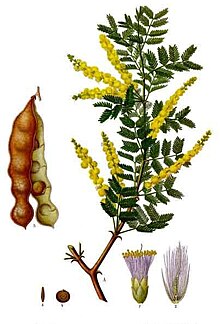Senegalia senegal (also known as Acacia senegal) is a small thorny deciduous tree from the genus Senegalia, which is known by several common names, including gum acacia, gum arabic tree, Sudan gum and Sudan gum arabic. In parts of India, it is known as Kher or Khor.[2] It is native to semi-desert regions of Sub-Saharan Africa, as well as Oman, Pakistan, and west coastal India. It grows to a height of 5–12 metres (16-40'), with a trunk up to 30 cm (1') in diameter.[3] Sudan is the source of the world's highest quality gum arabic, known locally as hashab gum in contrast to the related, but inferior, gum arabic from Red acacia or talah gum.[4]
| Senegalia senegal | |
|---|---|

| |
| Scientific classification | |
| Kingdom: | Plantae |
| Clade: | Tracheophytes |
| Clade: | Angiosperms |
| Clade: | Eudicots |
| Clade: | Rosids |
| Order: | Fabales |
| Family: | Fabaceae |
| Subfamily: | Caesalpinioideae |
| Clade: | Mimosoid clade |
| Genus: | Senegalia |
| Species: | S. senegal
|
| Binomial name | |
| Senegalia senegal (L.) Britton
| |
| Synonyms[1] | |
| |
Uses
editGum arabic
editThe tree is of great economic importance for the gum arabic it produces which is used as a food additive, in crafts, and as a cosmetic. The gum is drained from cuts in the bark, and an individual tree will yield 200 to 300 grams (7 to 10 oz). Eighty percent of the world's gum arabic is produced in Sudan.[5] The Chauhatan area of Barmer district in Rajasthan is also famous for gum production, this is called कुम्मट[6] (Kummat) in local language there.
Forage
editNew foliage is very useful as forage.[7] Leaves and pods of S. senegal are browsed by domestic and wild ruminants.[8]
Agriculture
editLike other legume species, S. senegal fixes nitrogen within Rhizobia or nitrogen-fixing bacteria living in root nodules.[4] This nitrogen fixation enriches the poor soils where it is grown, allowing for the rotation of other crops in naturally nutrient-poor regions.
Traditional uses
editIt has been reportedly used for its astringent properties, to treat bleeding, bronchitis, cough, diarrhea, dysentery, catarrh, gonorrhea, leprosy, typhoid fever and upper respiratory tract infections.[7][unreliable medical source?][9]
Rope
editRoots near the surface of the ground are quite useful in making all kinds of very strong ropes and cords. The tree bark is also used to make rope.[7]
Wood
editThe wood of S. senegal can be used to make handles for tools, and parts for weaving looms.[7] It is also valued as firewood and can be used to produce charcoal.[8]
Chemistry
editS. senegal contains hentriacontane, a solid, long-chain alkane hydrocarbon. The leaf also contains the psychoactive alkaloid dimethyltryptamine.[10]
-
A Gum acacia tree photographed at Taljai Hills, Pune
-
Senegalia senegal
See also
editReferences
edit- ^ "Acacia senegal (L.) Willd. — the Plant List".
- ^ Pervez, Amjad; Ahmad, Syed Muzaffar; Lathiya, Shaher Bano; Khadijah, Erum (2009). "Food Habits of the Indian Crested Porcupine, Hystrix indica in Sindh, Pakistan". Pakistan Journal of Zoology. 41 (4): 321. ISSN 0030-9923. ProQuest 992958322.
- ^ World Agroforestry Centre Archived 2007-05-15 at the Wayback Machine
- ^ a b Suliman, Mohamed Osman (2011). The Darfur Conflict : Geography or Institutions. New York: Routledge. ISBN 978-0-415-88598-0.
- ^ "Gum arabic in Sudan: production and socio-economic aspects, United Nations Food & Agricultural Organisation"
- ^ "हिंदी खबर, Latest News in Hindi, हिंदी समाचार, ताजा खबर". Patrika (in Hindi). Retrieved 7 December 2020.
- ^ a b c d "Acacia senegal". www.hort.purdue.edu. Retrieved 2017-08-03.
- ^ a b Heuzé V., Thiollet H., Tran G., Hassoun P., Bastianelli D., Lebas F., 2016. Gum arabic tree (Acacia senegal). Feedipedia, a programme by INRA, CIRAD, AFZ and FAO. https://www.feedipedia.org/node/342
- ^ Wren, R.C. (1923). Potter's Cylopedia of Botanical Drugs and Preparations. London: Potter & Clark. p. 2.
- ^ Khalil, S.K.W. & Elkheir, Y.M. 1975. “Dimethyltryptamine from the leafs of certain Acacia species of Northern Sudan.” Lloydia 38(3):176-177.